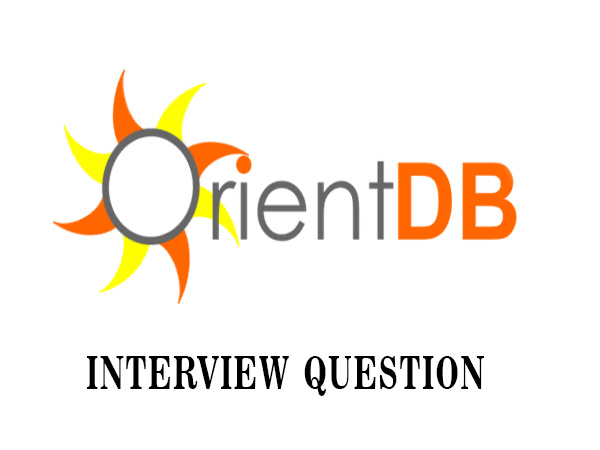Below are the list of OrientDB interview questions and their answers
OrientDB Interview Questions

Below are the list of Best OrientDB Interview Questions and Answers
OrientDB is an open-source NoSQL database management system that is written in Java. It supports a Multi-model database, supporting graph, document, key/value, and object models. It offers several indexing mechanisms based on B-tree and Extendible hashing, the last one is known as "hash index". It implements LSM-tree and Fractal tree index based indexes.
- Some uses of OrientDB are as follows:
- It is used to store data and provide facilities (tools) to search for specific records in a given set of data.
- It is used to store special information used to manage the data. This information is called metadata and it is not shown to all the people looking at the data.
- IT is used to solve cases where many users want to access (and possibly change) the same entries of data.
- It is used to manage access rights (who is allowed to see the data, who can change it)
- It is used to track information about users, their name, login information, various addresses, and phone numbers.
Few advantages of OrientDB are listed below:
- It is integration of Many database modules into one db.
- It provides good user profile based security system.
- It has SQL engine developed from scratch to improve performance.
- It supports Storage caching that is better for reducing latency.
- It allows Remote connection with increased transaction isolation.
The differences between MongoDB and OrientDB are as follows:
| MongoDB | OrientDB |
|---|---|
| Doesn't require a unified data structure. | Multi-model database (document, object, graph). |
| Easy to scale | Open Source commercial friendly license (Apache 2). |
| Great speed | Free clustering support. |
| Perfect documentation and tutorials. | Performance is very fast. |
| It uses JSON. | Supports SQL as well as other query languages. |
Yes, OrientDB supports transactions ACID properties.
Different types of data types available in OrientDB are as follows:
- Boolean
- Integer
- Short
- Long
- Float
- Double
- Date-time
- String
- Binary
- Embedded
- Embedded list
- Embedded set
- Embedded map
- Link
- Link list
- Link set
- Link map
- Byte
- Transient
- Date
- Custom
- Decimal
- LinkBag
- Any
Clusters are used in OrientDB to store links to the data. It is a generic way to group records. Some examples of how clusters may be used are as follows: Example 1: Use the cluster "Person" to group all the records of type "Person". Example 2: Use the cluster "Cache" to group all the records most accessed. Example 3: Use the cluster "Today" to group all the records created today. Example 4: Use the cluster "CityCar" to group all the city cars.
OrientDB adheres to the TinkerPop Blueprints standard and uses it as the default Graph API. It is used to handle Graph Databases with the help of a complete stack such as Blueprints, Pipes, Gremlin, Rexster, and sail Ouplementation.
Connect to the server and the LIST DATABASES command is used to list all Databases in OrientDB.
What is a Graph Database?A database that is based on graph theory is known as a graph database that consists of a set of objects such as a node or an edge. It can be used to store complex data structures that would be infeasible in a traditional relational database.
A Multi-model database is a database. It can store, index, and query data in more than one model. A database that supported a relational database, document-oriented database, graph database, or triplestore is multi-model.
OrientDB provides a RecordBytes record generally known as BLOB(after OrientDB v2.2) that can also load and store binary data. It is a little similar to a Document, a Vertex, or even an Edge. It can be used on record in OrientDB.
Vertex in OrientDB is the most basic unit of data. It is also known as a Node in Graph Databases. Vertex is responsible for storing information for the database. In OrientDB two vertexes are connected with an Edge.
Latest Interview Questions-
Silverlight Interview Questions
-
Entity framework interview questions
-
LINQ Interview Questions
-
MVC Interview Questions
-
ADO.Net Interview Questions
-
VB.Net Interview Questions
-
Microservices Interview Questions
-
Power Bi Interview Questions
-
Core Java Interview Questions
-
Kotlin Interview Questions
-
JavaScript Interview Questions
-
Java collections Interview Questions
-
Automation Testing Interview Questions
-
Vue.js Interview Questions
-
Web Designing Interview Questions
-
PPC Interview Questions
-
Python Interview Questions
-
Objective C Interview Questions
-
Swift Interview Questions
-
Android Interview Questions
-
IOS Interview Questions
-
UI5 interview questions
-
Raspberry Pi Interview Questions
-
IoT Interview Questions
-
HTML Interview Questions
-
Tailwind CSS Interview Questions
-
Flutter Interview Questions
-
IONIC Framework Interview Questions
-
Solidity Interview Questions
-
React Js Interview Questions
Subscribe Our NewsLetter
Never Miss an Articles from us.
